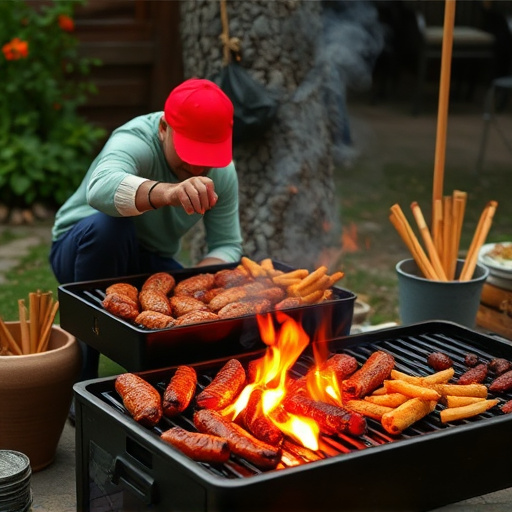When choosing BBQ ribs for an oven-baked recipe, opt for meaty cuts like baby back or spareribs preheated to 300°F (150°C) for slow roasting. Select ribs with natural glaze or create a dry rub blend for flavor. Baby back, spareribs, and St. Louis style offer distinct cooking methods. Prioritize quality and freshness by storing properly and handling cleanly. Use a dry rub for easy preparation and a balanced taste, or a wet rub for intense flavor and moisture. Enhance ribs with marinades or brines for extra tenderness. Follow a step-by-step guide: preheat oven, prepare ribs, bake until tender, remove foil, glaze with BBQ sauce, and return to oven for a caramelized finish.
Looking for a delicious and easy BBQ ribs recipe that’s perfect for any occasion? This comprehensive guide will transform you into a rib-master! We’ll explore the ins and outs of choosing the right ribs, from baby back to St. Louis style, and mastering preparation techniques for tender, juicy results. Learn about dry rubs vs. wet rubs, oven cooking methods, and the art of basting. Discover how long to cook BBQ ribs in the oven, along with sauce options and pairing suggestions. Rest assured, with our step-by-step instructions and expert tips, your next rib gathering will be a resounding success!
- Choosing the Right Ribs
- – Types of ribs: Baby back, spareribs, St. Louis style
- – Selecting quality and freshness
- Preparation Tips for Tender Ribs
- – Dry rub vs. wet rub: Pros and cons
- – Marinating and brining techniques for enhanced flavor
- Oven Cooking Method: A Step-by-Step Guide
Choosing the Right Ribs
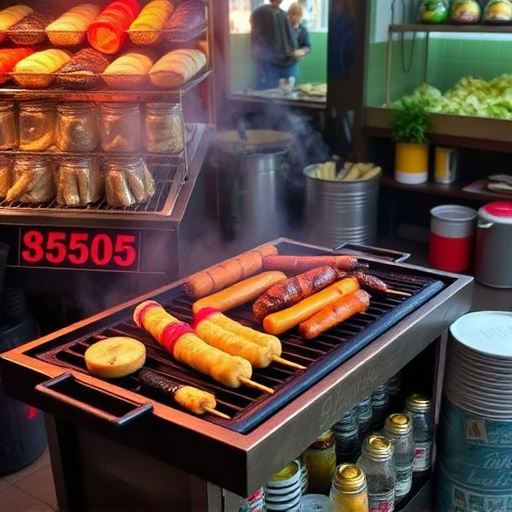
When it comes to choosing the perfect ribs for your next BBQ, opt for meaty, well-marbled cuts like baby back or spareribs. These cuts tend to be more tender and have a good balance of fat and meat, ensuring they stay juicy and flavorful during the cooking process. Look for ribs with a good layer of natural glaze or rub already applied for extra taste, but remember, you can always create your own rub blend to suit your preferences.
For an easier and faster oven-baked BBQ ribs recipe, select ribs that are meaty and have some fat cap. This will help them cook evenly and prevent dryness. Preheating the oven to 300°F (150°C) is ideal for slow-roasting the ribs, allowing the meat to tenderize and the sauce to penetrate deeply. This method eliminates the need for smoking or long grill times, making it a convenient choice for any occasion.
– Types of ribs: Baby back, spareribs, St. Louis style
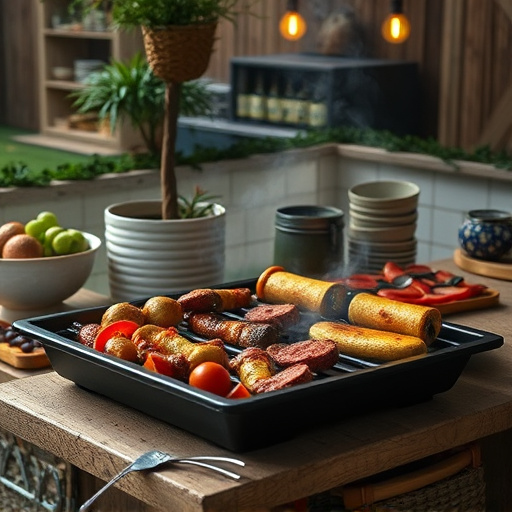
When it comes to ribs, there are three main types that dominate the BBQ scene: baby back, spareribs, and St. Louis style. Each has its unique characteristics and cooking methods. Baby back ribs, as the name suggests, come from the smallest part of the pig’s ribcage, making them tender and suitable for an oven-baked BBQ ribs recipe. They have less meat between the bones, resulting in a more delicate flavor profile that shines when cooked slowly.
Spareribs, on the other hand, are the most common type used for slow-cooked, oven-roasted ribs. They consist of a larger section of ribs with more meat attached to the bones, offering a hearty and meaty experience. St. Louis style ribs, often referred to as “cut in between” or “spare rib tips,” have been separated from the spareribs into smaller individual cuts, making them ideal for BBQ recipes that require faster cooking times and easier serving. These types of ribs can be easily adapted to an oven-baked approach for a quick and delicious meal.
– Selecting quality and freshness
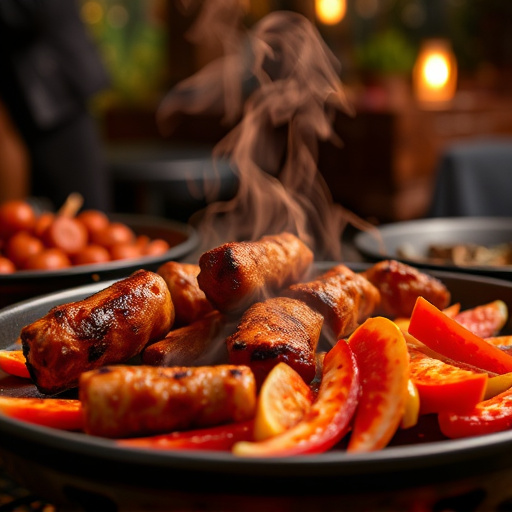
When it comes to selecting the perfect BBQ ribs for your oven-baked dish, quality and freshness are key. Opting for high-quality, well-marbled cuts ensures a tender and juicy result every time. Look for ribs with a good amount of meat attached to the bone, as this indicates a higher fat content, which keeps the ribs moist during the baking process. Freshness is equally important; choose ribs that are stored properly and bought from reliable sources to guarantee the best flavor and quality.
Avoid old or dried-out cuts, as they may result in tough, chewy ribs. Instead, select ribs that have a vibrant, pinkish hue and emit a savory aroma when you squeeze them gently. Proper storage is also crucial; keep your ribs refrigerated until you’re ready to cook them, and always handle them with clean hands or utensils to prevent any unwanted bacteria from compromising their freshness.
Preparation Tips for Tender Ribs
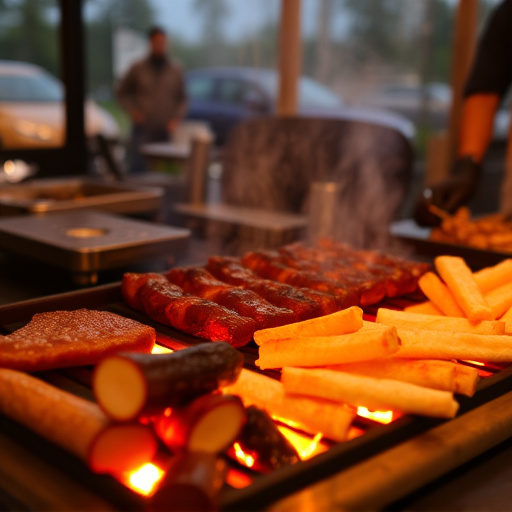
When preparing BBQ ribs in the oven, there are a few key tips to ensure they turn out tender and mouthwatering. First, choose a good quality cut of pork ribs, such as baby back or spareribs, for the best results. Before cooking, dry rub is essential; it helps to break down collagen and makes the ribs incredibly juicy and flavorful. Use a generous amount of your favorite BBQ spice blend and massage it into the meat.
For even cooking, prepare your oven to a low temperature, typically around 250°F (120°C). This slow cooking process is crucial for tenderizing the ribs. Consider wrapping them in foil after the initial stage to retain moisture, but avoid overcooking—a perfect balance of smoky and tender is the goal!
– Dry rub vs. wet rub: Pros and cons
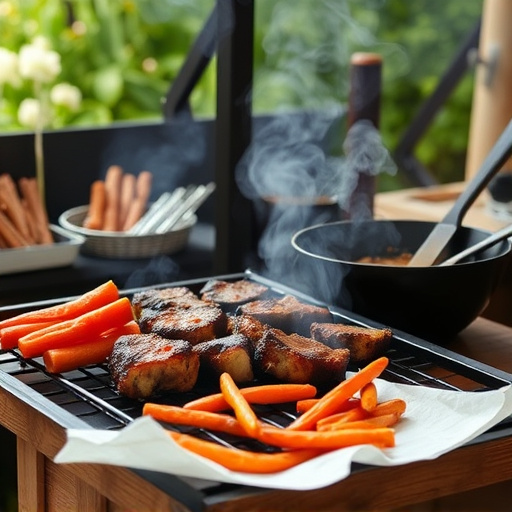
When it comes to seasoning your BBQ ribs, there are two primary approaches: dry rub and wet rub. A dry rub is a blend of spices that’s directly applied to the meat, creating a crusty exterior with intense flavor. The pros include easier preparation since you don’t need any additional liquids, and the dry rub can be easily adjusted to suit your taste preferences. It also promotes a nice crackly texture when cooked in an oven. However, the downside is that it might not penetrate as deeply into the meat compared to wet rubs.
On the other hand, a wet rub involves mixing spices with liquid ingredients like vinegar, brown sugar, or beer. This approach ensures better flavor penetration, tenderizing the ribs, and adding moisture. It’s perfect for those who prefer a more succulent rib experience. Yet, it requires extra preparation time, and the additional liquid might make the cooking process slightly more complicated in an oven setting. For our quick and easy BBQ ribs recipe, we opt for a dry rub to balance flavor intensity with simplicity.
– Marinating and brining techniques for enhanced flavor
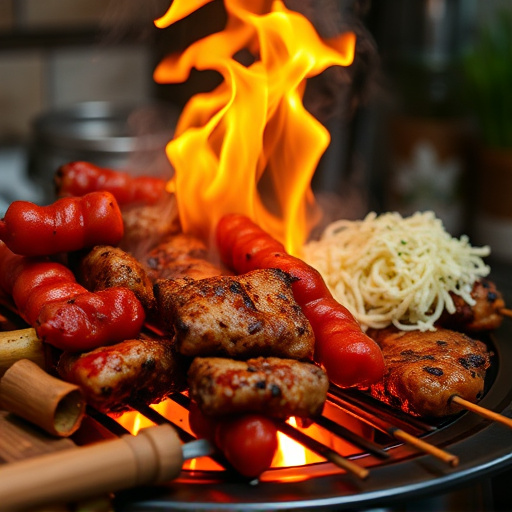
Marinating and brining are simple yet powerful techniques that can significantly enhance the flavor of your BBQ ribs, whether cooked in the oven or on the grill. Marinades provide a flavorful liquid solution that penetrates the meat, adding richness and depth. Acids like lemon juice or vinegar help break down proteins, making the ribs more tender. Oils and herbs create a delicious coating that clings to the meat, amplifying its natural tastes.
Brining, on the other hand, involves submerging the ribs in a salt-rich solution for several hours or even overnight. This process draws out some moisture from the meat, which then reabsorbs it, resulting in incredibly tender and juicy ribs. The salt also helps to break down connective tissues, making the ribs easier to chew and more enjoyable to eat. Combine these techniques with your favorite BBQ sauce for an unforgettable oven-baked rib experience.
Oven Cooking Method: A Step-by-Step Guide
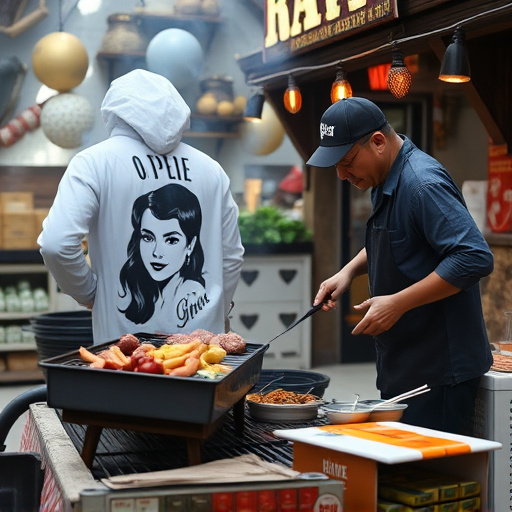
Oven Cooking Method: A Step-by-Step Guide
Preheating your oven to 350°F (180°C) is the first step in preparing these mouthwatering BBQ ribs. Next, place your rack of ribs in a large baking dish, and generously rub both sides with your favorite BBQ spice mix or a dry rub. This step infuses the ribs with flavor and ensures a delicious crust. Cover the dish loosely with aluminum foil, locking in the moisture while allowing some heat to escape. Bake for approximately 2 hours, or until the meat starts to tenderize and easily peels away from the bone.
Once cooked, carefully remove the foil and increase the oven temperature to 400°F (200°C). Brush both sides of the ribs with BBQ sauce, ensuring they’re well coated. Return the ribs to the oven for an additional 15-20 minutes, allowing the sauce to caramelize and create a sticky, savory glaze. This final touch adds that signature BBQ rib flavor and makes them ready to serve at your next gathering.
